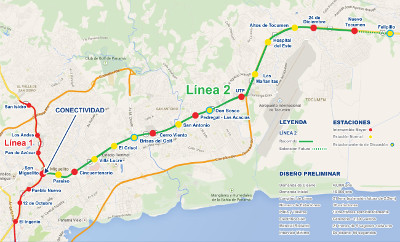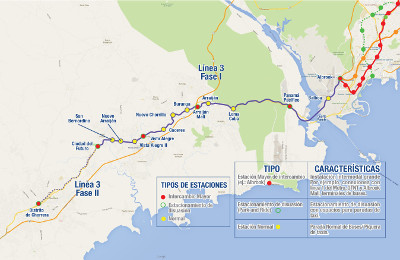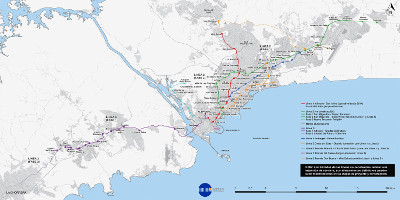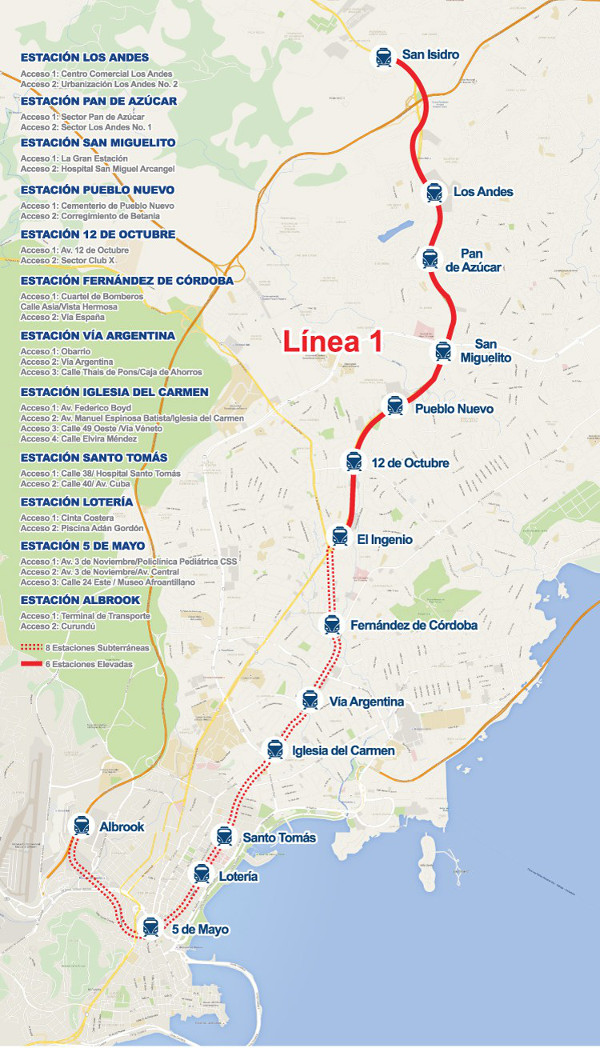The Panama Metro has one line that extends 15.8 kilometers (9.8 miles). It provides service to 14 stations as it travels from north to south and passes through the city center.
The Panama Metro schedule runs from 6:00 a.m. to 10:00 p.m., from Monday to Sunday, regardless of holidays or special celebrations. The train frequency is about every 3-8 minutes, depending on the time of day.
Each metro trip costs $US 0.35.
The Panama Metro does not have a direct connection to the Tocumen International Airport.
Panama Metro
Founded on August 15, 1519, Panama City is the capital and the most populated city in Panama. Currently, there are 2,000,000 people living in the metropolitan area, which makes up almost half of the country’s total population.
The landscape of this metropolis has transformed radically since its economic boom, at the beginning of the century. It went from having four or five skyscrapers on the horizon to nearly 48, in addition to the many others already under construction.
This economic boom contributed to the country’s position as an emerging economy. It grew into one of the region’s most important air and water traffic control centers due to its striking geographic strategy.
This development ignited the creation of infrastructure to meet the needs of residents, who were inundated by the major growth. They desperately needed health, education and transportation systems, to match Panama City’s new reality.
The Panama Metro was one of these projects. It began to go up in 2011. Officials began a process of selecting a company to manage it in 2009, the same year that the companies, FCC and Odebrecht were contracted for construction.
Work was set in motion on February 14, 2011, with plans for the first line to extend about 15 kilometers (9.3 miles) and have 14 stations. The modern-day Panama Metro opened on April 4, 2014. Considering its estimated length and the number of stops, many classified this as record time.
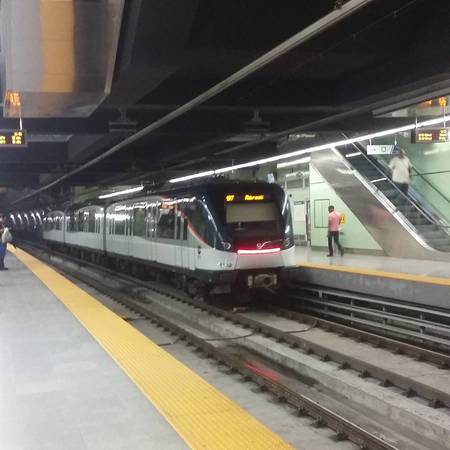 Panama Metro
Panama Metro
As part of the city’s master plan, there are two more routes in progress. The plan is expected to include a 10-million-dollar investment in public transportation, lasting until 2035.
Lines and stations
The Panama Metro currently has just one operating line. Its railway extends 15.8 kilometers (9.8 miles) although it reached just barely 13.7 kilometers (8.5 miles) during its inauguration.
This line’s route services 14 stations while traveling from north to south and passing through the city center.
Operations began on April 4, 2014, followed by a one-month testing period, that included free trips.
After the 2014 project was complete, the Brazilian company, Odebrecht and the Spanish company, FCC gradually expanded and annexed new stops, until the present length was reached.
Stations
- Albrook: This station is located south of the city, in Ancón township, near the famous Panama Canal. It has been in service since 2014.
- 5 de Mayo: This stop is located in Calidonia township, where it also provides service to the residents of Santa Ana township. It is very close to Panama’s Casco Viejo (Old Town) and has been in service since 2014.
- Lotería: This station is in Calidonia township, in the surrounding Justo Arosemena Avenue area. Inaugurated 4 months after service began on the main line, it has been operating since August 27, 2014.
- Santo Tomás: Found in the Calidonia township, this station is located in Justo Arosemena’s surrounding area. It is considerably close to the Hospital Santo Tomás and Cinta Costera (the Coastal Beltway). and has been operating since 2014.
- Iglesia del Carmen: This station is in the surrounding area of Vía España in the Bella Vista neighborhood. It is located near the Iglesia del Carmen as well as the city’s banking district. This station opened in 2014.
- Vía Argentina: This stop lies right at the intersection of Vía España and Vía Argentina in the Bella Vista neighborhood. It provides access to Panama City’s banking district as well as the nearby neighborhoods of Obarrio and El Cangrejo. Service began in 2014.
- Fernández de Córdoba: This station is found near Vía Fernández de Córdoba -from where it takes its name- in the neighborhood of Vista Hermosa. It is the busiest station in the system and has been operating since 2014.
- El Ingenio: This stop lies at the intersection of Vía Simón Bolívar and la Paz Avenue, located in El Ingenio neighborhood. Its doors opened on May 8, 2015.
- 12 de Octubre: This station is located at Vía Simón Bolívar and 12 de Octubre Avenue, where it provides service to the residents of Bethania and Pueblo Nuevo townships. It has been in service since 2014.
- Pueblo Nuevo: This station is located in Vía Simón Bolívar’s surrounding area, in the neighborhood of Pueblo Nuevo. The is the least busy station, although it is in one of the busiest zones in the Panamanian capital. It has been operating since 2014.
- San Miguelito: This station is at the intersection of Domingo Díaz Avenue, Vía Ricardo J. Alfaro and Vía Simón Bolívar. It has been in service since 2014.
- Pan de Azúcar: This stop services the area surrounding Transístmica Avenue in the neighborhood of Pan de Azúcar. It has been operating since 2014.
- Los Andes: This stop is on Transístmica Avenue in the Los Andes neighborhood. It has been operating since 2014.
- San Isidro: This station is in northern Panama City, in the neighborhood of San Isidro in the San Miguelito district. It has been in service since August 15, 2015.
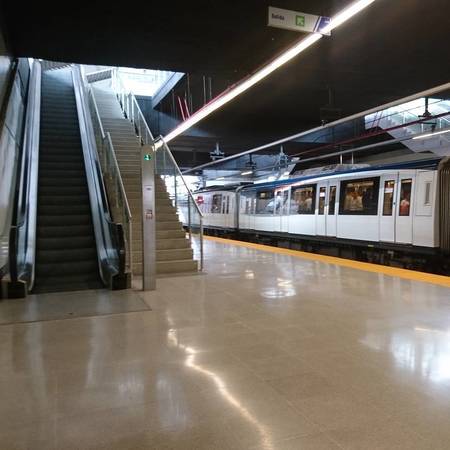 Panama City Metro
Panama City Metro
Schedule
The Panama Metro operates from 6:00 a.m. to 10:00 p.m. from Monday to Sunday, regardless of holidays or special celebrations. Trains usually reach the platform every 3-8 minutes, depending on the time of day.
During peak morning hours, from 6:00 a.m. to 9:00 a.m., and during peak evening hours, from 5:00 p.m. to 8:00 p.m., the wait time between trains is just 3-5 minutes. Trains arrive about every 5-8 minutes during the rest of the day.
Fares
The Panama Metro does not include monthly payment plans to which riders can subscribe. However, there is an established standard fare per trip, which riders must cancel through the use of a reloadable card, called the Tarjeta Metro.
These cards can be obtained from automated machines that are found throughout the system stations. The cost is $US 2.00 and they may also be used on the city’s urban bus routes.
Each metro trip is $US 0.35, discounted with the Tarjeta Metro. Authorized service personnel advise riders to store a weekly balance of $US 5.00 on their card. This will facilitate movement throughout the stations, although each charge will just be for the specific amount needed.
The subway cannot be used without the metro card, so it is extremely important to pick one up. Cards can be purchased or reloaded at station machines or at authorized agents located throughout the city.
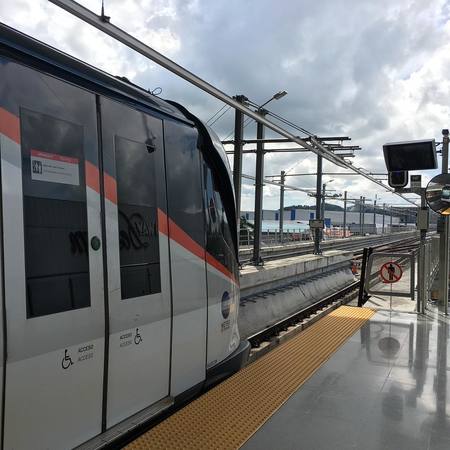 Panama Metro train
Panama Metro train
Student fares
All primary and secondary students receive a 50% discount on Panama Metro fares. Trips are just $US 0.17. However, only two trips can be taken per day at the reduced fare. Regular fare must be paid for any additional trips.
Students wishing to take advantage of this benefit must be properly registered in the Transit Authority and Land Transportation database. This is the same entity in charge of maintaining information on high school graduates who use the MetroBús.
However, the following restrictions apply to student fares:
- Reduced fares are only available between 5:00 a.m. and 8:00 p.m., Monday through Friday.
- The discounted fair is not valid during school breaks.
- The fare is also not valid during holidays or days of national grief.
- The benefit can only be used twice daily.
- Fares for retired, elderly and disabled people
- To acquire this fare, one must satisfy particular minimum requirements, which will be detailed later. Each trip is $US 0.24 and it must be completed with a personalized metro card that identifies the individual as the authorized user.
Requirements for retired and elderly people
- Copy of both sides of your identification card.
- Photocopy of the metro or MetroBús card that is already being used, in order to attain the current identification number.
- Residential address and local telephone number.
- Payment of $US 4.00, for the personalization of your new card.
Requirements for people with disabilities
- Copy of certificate issued by the National Secretary for Disability.
- Copy of both sides of your identification card.
- Photocopy of the metro or MetroBús card that is already being used, in order to attain the current identification number.
- Payment of $US 4.00, for the personalization of your new card.
- Residential address and local telephone number
Note: You must keep your ID on hand if using a discounted card for retirees, elderly or disabled people, in case Panama Metro authorities ask for identification to verify appropriate use.
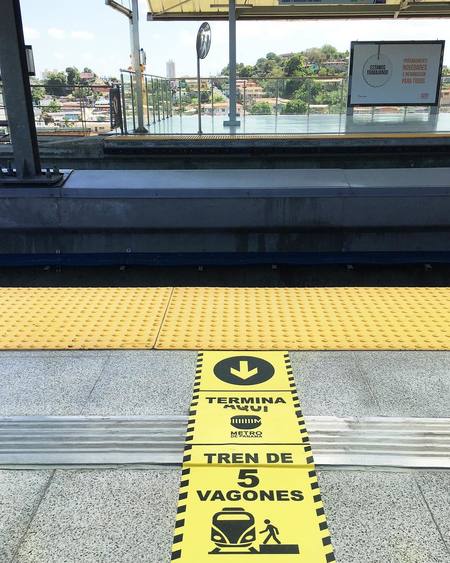
Regulations
- While waiting for the train to arrive, one should be sure to remain behind the yellow line, to avoid any possible accidents.
- Allow passengers to get off the train before boarding. This expedites the process.
- Keep to the right when traveling throughout the system. This will create more organized mobility throughout the stations.
- Smoking is prohibited in Panama Metro stations and facilities.
- Riders who are under the influence of alcohol or drugs are not permitted in the system.
- Insulting, harassing or putting other riders’ lives at risk is prohibited.
- Any attempt to sabotage or damage the system facilities will be subdued.
- Eating is not permitted on trains or in stations.
- Small children must be accompanied by a responsible individual.
- Sitting on stairs and leaning on walls is not permitted.
- Under no circumstances is being on or attempting to cross the railway tracks permitted.
- Accessing areas that are especially designated for service personnel is prohibited.
- Pets are not permitted on the Panama Metro.
- Running is not permitted in stations or in trains.
- When playing music on portable devices, headphones must be used. This will avoid interference with the messages that are transmitted by train operators.
- Baby strollers must be closed when entering the train cars.
- Only turnstiles with green lights should be used.
- Dirtying system facilities should be avoided. Officials will fine individuals for this.
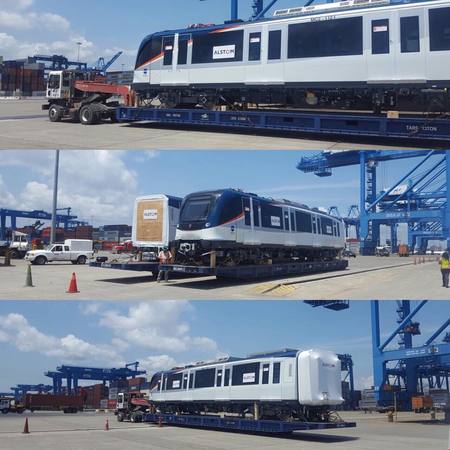
Connection to the airport
The Panama Metro does not have a direct connection to the Tocumen International Airport. However, there are connections available by bus
The airport can be reached by getting off at Albrook metro station, in the city’s southern zone. From there, one should go to Albrook–Bahía E bus stop, found a few meters away. It is essential to then take the buses serving the Tocumen–Corredor Sur–Albrook route since they stop at the terminal area stop.
The trip usually lasts between 40-45 minutes and costs $US 0.70, which can be purchased with a metro card or MetroBús fare. There are 11 bus stops on this line, prior to reaching your destination at the Aeropuerto-I terminal stop.
Similarly, metro services can also be used to reach Panama City from the airport. One must simply board the buses in the direction of Albrook–Bahía E, that will drop you directly at Albrook station.
However, from the Aeropuerto-I stop, it is also possible to board buses on the Albrook- Bahía B route, which stop at San Miguelito metro station. This second option costs a little less, as the bus route for this section costs just $US 0.25.
There are various options for getting from the air terminal to the city. They include taxis and rental vehicles that ensure the best service possible.
Connections
The Panama Metro has bus stops near several of its stations. They include the following:
- Albrook: Provides access to bus stops, Albrook–Bahía H, Albrook–Bahía G, Albrook–Bahía B, Albrook–Bahía E and the National Transport Terminal.
- 5 de Mayo: Provides access to bus stops, Marañón, Gimnasio Maranon, Piquera de Buses Balboa & Diablo, El Límite Calidonia and M. Calidonia.
- Iglesia del Carmen: Provides access to bus stops, Iglesia del Carmen and Parada Sol de la India.
- Vía Argentina: Provides access to bus stops, Calle Ernestina Sucre Tapia and Galerías Obarrio.
- Fernández de Córdoba: Provides access to bus stops, Furniture City Vía España, Furniture City-R, Carrasquilla-I and Vía Fernández de Córdoba/Calle 64 Oeste.
- El Ingenio: Provides access to bus stops, Escuela Manuel E. Amador, Parada a Pueblo Nuevo and El Ingenio.
- 12 de Octubre: Provides access to bus stops, Transístmica and Castilla de Oro.
- Pueblo Nuevo: Provides access to bus stops, Calle 81 Oeste-I, Calle 81 Oeste-R, Parada del Cementerio and Parada de Bandag.
- San Miguelito: Provides access to bus stops, Machetazo San Miguelito.
- Pan de Azúcar: Provides access to bus stops, Moya, Rodapán and Pan de Azúcar.
- Los Andes: Provides access to bus stops, Centro Comercial Los Andes, Piquera de Rutas Interna de Veranillo and Industrias de Buena Voluntad-I. Provides access to bus stops
- San Isidro: Provides access to bus stops, Entrada Tinajitas, Cruce San Isidro, Parada de la entrada de San Isidro (poly clinic), Estación San Isidro R and Parada de Campo Verde (Pozuelo).
Notable Facts
- Of the Panama Metro’s 14 stations, just 8 are underground. The other 6 are elevated, on the surface.
- Line 1’s total length is 16 kilometers (9.95 miles) which runs from Albrook station to San Isidro and can be traveled in about 26 minutes
- Despite its small size, the Panama Metro’s daily demand is high. Between 240 to 280 thousand passengers ride it every day.
- Due to the high demand for metro services in just its first year of operations, metro officials deemed it necessary to acquire 70 additional train cars.
- The purchase included an increase in the number of trains, going from its initial 20 to 26. Each train consists of five cars, with a capacity for 1,000 riders.
- Passengers can enjoy a mobile connection-voice and data-throughout their entire trip.
Future Expansions
The Panama Metro project is part of the Panama Metro Master Plan. It is expected to be completed by 2035. The current outline includes the construction of 7 additional lines. According to official estimates, it is expected that its completion will absorb 50% of Panama City’s demand for public transportation.
The main objective is to provide a rapid transit railway that connects the capital’s northern and southern communities to the city center as well as other areas. Daily service should reach over 1 million passengers in the future.
Line 2 has been under construction since 2015, with an expected duration of about 4 years. The consortium that carried out the project is the same one that built line 1. It is composed of the Spanish company FCC and the Brazilian company, Odebrecht. The route will be 21 kilometers (13 miles) and extend from San Miguelito neighborhood to Nuevo Tocumen’s surrounding areas.
Future Expansions Maps
Tourist Sites
Panama City’s Casco Viejo (Old Town) is located near the 5 de Mayo station. It was declared a UNESCO World Heritage Site in 1997. This is a colonial style area with narrow streets and picturesque surfaces. Its surroundings are filled with restaurants –including native and fine food-, hotels, squares and monuments located here and there. There is a special glow at nightfall, when the spaces are filled with life from the presence of tourists and merchants selling souvenirs. This type of immersion with the people and traditions is the perfect way to get to know the essence of Panama.
The bus from Albrook station at the Bahía–E stop, which includes the Albrook–Isla Flamenco–Amador route, can also be taken to visit the iconic Biomuseo. The museum holds both permanent and temporary exhibitions, with a special emphasis on ecology. Its goal was to raise awareness among citizens on the importance of the environment. With the inclusion of spaces for leaning, leisure and observation, it stands as one of the country’s most interesting sites and a must-see before leaving.
Metro map of Panama
Map via www.elmetrodepanama.comSee map full resolution. It may take a little bit to load.
Download map.
Panama metro map
- Passengers/Day 180000
- Fares: 0.35
- 24h operation: No
- Air Conditioning:
- Walk between platforms:
- Driverless trains: No
- Screen Doors Platforms:
- Average Speed: 50km/h
- Operator: El Metro de Panamá
- 0.35$
- Panama Metro Official Website
- Tlf: 504-7120
Help us
If you consider that the information we provide is wrong, not accurated, outdated, translation contains errors, and you would like to help us to improve the file...you can contact us here.
Feel free to contact us if you dont find the system you're looking for and we'll add it as soon as we can!
Thank you very much!







